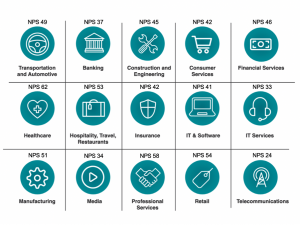In our recent post Telecom Digital User Experience – why is it so bad? And how did we get here?, we focused on the advantages of providing a stellar digital customer experience (CX) from the user perspective. But an excellent digital CX benefits both the customer and the service provider. In this article, I will highlight the value it adds to the service providers.
Due to the omnipresence of digital transformation, nowadays people see the world through a digital lens. The digital experience overlaps with the customer experience prompting companies to combine their online and offline efforts. According to the recent study by Forrester, nearly everyone understands that digital transformation is essential to driving customer experience and that customer experience is the key to competing in the age of the customer. Yet 25% of brands fail to meet customer expectations. The majority of telecom companies are among them.
One of the most effective methods to measure customer loyalty, and thus successful CX, is Net Promoter Score (NPS). It provides an answer to the question “How likely are you to recommend [brand name] to [a friend/family/business associate/…]?” and is assessed on a scale of -100 to +100. The telecommunications industry has long underperformed in customer experience. With an NPS average of 24, telecom holds the lowest industry average according to the NPS® Benchmarks Report 2018.

These findings carry unenthusiastic news for the telecom companies. In general, CX high performers are able to outperform their peers, drive better business results including increased revenue, better differentiation, and increased customer satisfaction and loyalty. Companies struggling with CX are, therefore, missing on many opportunities and losing customers in favour of more tech-oriented competitors.
For telcos, having an efficient digital CX in place translates to several significant benefits. Firstly, it allows for lower customer service costs. Operators recognise the importance of providing excellent customer support through several channels. However, customers, just as their value, are not equal. Hence, their treatment should not be the same. Higher-value customers should receive higher-quality service through direct channels, while operators migrate lower-value customers to alternative channels.
According to Deloitte’s Technology Industry Outlook 2017, cloud computing and AI are the main opportunities for telecommunication companies to digitally reimagine their businesses. These technologies enable companies to implement automated customer support, such as help centres or chatbots. They provide effortless, on-demand and personalised experiences 24/7 while reducing the cost of human support representatives. They eliminate high-volume, mundane and repetitive queries and allow the human agents to resolve high-touch and complex issues faster. What is more, automating customer service does not reflect negatively on customers’ attitude towards an operator. According to The NPS Industry Benchmark, 27% of customers do not even know whether their last customer service interaction was with a human or a chatbot, whereas 43% would pay extra for a hybrid human-bot customer service channel.
Furthermore, a well-performing digital CX can lead to increased retention by understanding the drivers of retention and calculating churn likelihood. It requires telco brands to leverage predictive analytics. Operators have a wealth of customer and network data at their disposal that can provide insights into customer behaviour and predict when the customer is at the verge of terminating the service. Having predictive analytics in place, they can undertake proactive actions when a customer signals the possibility to drop out by delivering customised service.
Customer churn analysis allows for building a sustainable business and maximising revenues since, according to the authors of “Leading on the Edge of Chaos”, reducing customer churn by 5% can increase profits by 25-125%. Additionally, it helps to gather valuable customer behaviour, transactions, demographics data and usage pattern. That, in turn, allows for building and fostering customer relationships, implementing effective customer retention programmes and utilising the data to seamlessly upsell tailored products and services.
Perfect digital CX and happy customers can lead to another benefit for telco companies: lower customer acquisition cost. We live in an era of openly sharing our opinions and experiences both offline and online. If positive, those opinions can become a successful (and free) marketing campaign. Word-of-mouth is the most trusted marketing tool as it is separate from a brand and people trust it more than advertisements. In fact, 75% of people do not believe advertisements, but 90% believe brand recommendations from friends. Therefore, telco companies should focus on perfecting their CX as well as identifying and encouraging customers that admire their brands to share their positive experiences and amplify their reach.
On the other side, negative reviews prove to be a valuable source of information too. They tend to highlight underperforming features of the CX that should be enhanced and developed to better meet customer needs. It also fosters customer relationships, improves loyalty and retention. Unhappy customer, who receives excellent customer service is likely to become a brand ambassador as he/she feels valued, heard and is more intimately acquainted with the brand’s CX and its iterative nature.
To sustain business growth amid the digital transformation age, telecom companies must ensure that stellar digital customer experience is an inseparable part of their core offering. Fostering advanced digital solutions can result in plenty of favourable outcomes, including lower customer service cost, reduced churn rate and lower customer acquisition costs. These, in turn, enable a strong competitive performance, the ability to meet contemporary customer demands and drive new revenue streams.



